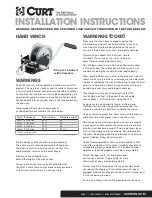
Owner's Manual for TA150KGMR1 Pneumatic Winches for Personnel Lifting
page 11
A12876A-1214
1.4
Connecting Air Supply to the Winch
All control devices must be momentary type. Install all control devices so the
winch motor will stop when the operator releases the device.
Locate control devices so the operator will be able to view the rider through
the entire operation.
Locate control devices so the operator will be clear of the rider, the wire rope,
and the path of a broken wire rope that could snap back and cause injury.
Check that the direction indicators on control match rider direction.
NOTE: THE DIVERTER VALVE CAN BE USED AS A SHUT-OFF
VALVE UNLESS A SECONDARY AIR SUPPLY IS INSTALLED.
It is the responsibility of the owner to provide equipment for powering the
winch, The following guidelines are supplied as a reference for the installer.
1.4.1
CHECK THE COMPONENT MANUFACTURER'S INSTRUCTIONS for
installing auxilliary equipment.
1.4.2
ENSURE an accessible shut off valve has been installed in the air supply
line and make sure others are aware of its location.
A shut-off valve that shuts off the air when the E-stop is activated is included
as part of the air preparation unit (APU). An inline shut-off is recommended
for added security.
1.4.3
THE AIR SUPPLY must be clean and free from moisture. The dew point of
the air supply shall be low enough as to prevent condensation from forming
in the pneumatic components as the air is passed through the system.
Air preparation unit comes installed on the winch. The APU will provide
lubricant so external lubricator is not required.
a
ALL AIR SUPPLY LINES should be purged with clean, moisture free air or
nitrogen before connecting to winch inlet.
b
SUPPLY LINES should be as short and straight as installation conditions
will permit. Long transmission lines and excessive use of fittings, elbows,
tees, globe valves etc. cause a reduction in pressure due to restrictions and
surface friction in the lines.
c
AIR LINE LUBRICATOR on the winch should be replenished daily and set
to provide 3-4 drops per minute.
1.4.4
MOISTURE THAT REACHES THE AIR MOTOR through air supply lines is
a primary factor in determining the length of time between service overhauls.
a
MOISTURE TRAPS can help to reduce moisture.
b
AIR RECEIVERS collect moisture before it reaches the motor.
c
INSTALLING AN AFTERCOOLER at the compressor that cools the air to
condense and collect moisture prior to distribution through the supply lines
is also helpful.
1.4.5
THE WINCH SHOULD BE INSTALLED as near as possible to the
compressor or air receiver. Recommended pressures and volumes are
measured at the point of entry to the air motor.
1.4.6
CHECK THE AIR PRESSURE at the motor and make sure it agrees with the
pressure rating marked on the winch nameplate.
Important!
• Use components rated for the air
supply you will be using.
• Always disconnect the air supply
when the winch is not in use.
When removing the air hoses
from the unit, plug the open ports.
• Never install an additional
lubricator in-line for this winch.
A filter-regulator-lubricator is
integrated into the winch, and
pre-lubrication will clog the
winch’s filter.
• The pressure regulator on the
winch may be pre-set and
locked if required by the product
standard. Do not modify a
locked setting on the regulator.
Contact Thern for instructions if
re-adjustment is required.
• Check that the indicators on the
control match rider direction.





































